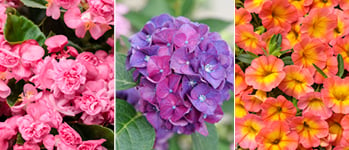All About Roots
All gardeners set out to grow healthy plants, but they also face a stubborn barrier, a curtain beyond which eyesight ends and mystery begins: the surface of the soil. Below, plants root in darkness, and our ministrations above ground only sometimes seem to determine whether our charges will go belly up or thrive.

Photo by: Saatchi Gallery, London © Jorge Mayet 2008.
Until recently, scientists, too, could make only calculated guesses about how things worked on the other side of the soil surface barrier. They knew that plants’ root zones, also known as rhizospheres, were full of microscopic organisms such as bacteria and fungi. Because these microbes are notoriously unwilling to grow in a laboratory, however, scientists found it nearly impossible to identify them, let alone determine how they interacted with plant roots. The default assumption was that roots were largely passive and had mechanical functions: They secured the plant’s footing, sucked up water and nutrients, and in the case of a carrot or turnip, stored food over the winter.
New investigative tools, including advances in photography, have pulled back the curtain and revealed a world of such complexity that researchers call it humbling and strange. Scientists can now dispense with culturing soil bugs and instead identify the members of a soil community by their DNA straight from environmental samples. What the researchers see is a root zone so full of life-there can be as many as 1 million distinct bacteria species in a single gram of soil-and so rich with chatter, unexpected alliances, and surprising acts of aggression that some of them compare it to that other great marketplace of communication, the Internet.
Far from serving as mere scaffolding in the midst of all this action, plant roots are arguably the Huffington Posts of the realm-aggregating the players, reacting to the news, and shaping the conversation to benefit themselves. One way roots alter their environment is by producing and then emitting an array of chemicals called exudates: Plants devote as much as 20 percent of the sugars they produce through photosynthesis to these chemicals. “The [plants] are losing well-made food that by rights they should be conserving,” says rhizosphere biologist Harsh Bais of the University of Delaware-a sure sign that the exudates accomplish something crucial. In fact, the plants are trading those sugars for fertilizers produced or supplied by soil microbes.
Two of these relationships are visible to the naked eye and have been broadly understood since the late 19th century. In one, legumes such as lupines and peas develop knobs on their roots that house bacteria called rhizobia. In return for sugars from the plants, rhizobia convert nitrogen from the air into a form the plants can use to grow.
Supporting Your Roots
1. Forget the chemicals. Organic soils encourage a greater balance and diversity of microbes to serve plants and better control pathogens.
2. Add organic matter. Compost, cover crops, manure, and mulches offer a habitat beneficial to soil creatures. The microbes that specialize in decomposing organic matter will unlock the nutrients in these materials to fertilize your plants.
3. Rethink the tiller. Tilling disrupts soil communities and destroys fungal networks.
4. Consider heirloom vegetables. Try planting varieties that preceded the development of artificial fertilizers and pesticides. Just as some newer cultivars have less flavor or fewer nutrients, they also may have lost their ability to attract as many plant-supportive microbes.
5. Look forward to a future full of better garden plants. Breeding programs might eventually focus on developing those plants able to attract the microbes that help them become both beautiful and robust.
Second, the vast majority of plants use their sugars to support fungi called mycorrhizae, which gardeners can see as a soft-focus white net surrounding plant roots. Above ground, mycorrhizae produce delicious mushrooms, including chanterelles and porcini. Underground, however, they form ultrafine filaments that far exceed the roots’ reach and fetch nutrients from distant places and crevices that would otherwise be inaccessible to the plant.
More recent research suggests that there are a wide range of such plant-microbe trading partnerships, and they involve the delivery of growth hormones as well as nutrients. These findings call into question how often—and how much—gardeners really need to fertilize their soil. “When it comes to managing nutrients in the garden,” explains Laurie Drinkwater, an agroecologist at Cornell University, “it’s important to understand that the system is geared to take up nutrients. We don’t need to add large amounts of chemical fertilizer.”
One potential problem with adding fertilizers is that of overdosing. Nitrogen that isn’t immediately taken up by the plant can pollute nearby waterways and, in the extreme, ultimately cause ocean dead zones. Microbially supplied fertilizers, on the other hand, may be produced in more judicious quantities and on more of an as-needed basis. According to a 2001 study, when a grass common in Yellowstone National Park was sheared of its leaves—as if grazed by bison—the rate at which the grass roots exuded sugars and other carbons doubled, in turn doubling the microbial populations there, which then more than doubled the amount of nitrogen available for the plants to regrow.
Of course, not every relationship between roots and microbes is benign, as any gardener who has ever lost a plant to verticillium wilt or crown gall can tell you. But scientists have uncovered one reason why disease is the exception rather than the rule in gardens: Certain exudates control pathogens. When sweet basil is threatened by thuggish water molds that cause root rot, for example, it secretes rosmarinic acid, a powerful antimicrobial that can knock back this threat. Other roots attract microbes that produce antibiotics or protective films.
Individual plants assemble microbial communities as distinctive as a fingerprint. “It’s not just different species of plants that bring in a particular set of microbes,” explains Tiffany Weir, a microbial ecologist at Colorado State University. “One variety of cucumber will attract different microbes than another variety.” In fact, a 2010 study of cucumber cultivars found that differences in their soil microbial communities seem to affect their susceptibility to fusarium wilt.
Qualities such as disease resistance, drought tolerance, and productivity were once assumed to be explained largely by a plant’s genetics. Instead, such characteristics may have more to do with the company a plant keeps. Ragan Callaway of the University of Montana, an expert on plant-to-plant interactions and invasives, offers up a dramatic example in work done by his student Marnie Rout. She has found that johnsongrass, a towering, man-size weed that shoulders out native plants, grows vigorously even in nitrogen-poor prairie soils because of nitrogen-fixing bacteria that live within its root tissues. “These bacteria give johnsongrass superpowers,” says Callaway. “Without the bacteria, it can’t compete.”
Exudates would be impressive enough if all they did was manage microbes. But exudates also alter the chemistry of the soil and referee plant-to-plant relations. Anyone who’s ever had trouble getting things to grow under a black walnut tree is familiar with allelopathy, the kill-or-be-killed phenomenon in which roots fight for resources by releasing chemicals toxic to their neighbors. On a friendlier note, scientists are also seeing evidence of diplomatic behavior, wherein plants use exudates to trade services with their fellows. For instance, when aphids attack a fava bean plant, it produces compounds that prompt neighboring favas to leaf out, attracting parasitic wasps that will kill the aphids.
Stranger still, certain plants, such as the mustard Arabidopsis thaliana, seem to recognize close kin through their exudates and politely limit their own root growth so everybody can share a single garden bed. Bais, who has done a study illuminating this behavior, finds it odd enough to deem it “bizarre.”
Bais suspects that kin recognition and stranger competition could explain many common garden successes and disappointments. “You can walk into Home Depot,” he says by way of example, “pick out two similar plants, same genus and species, but coming from different maternal lines. Plant them together; one will outcompete the other. You’ll assume you have one weird plant and blame the nursery.”
To some extent, the new science of the rhizosphere calls into question the notion of “culture” in gardening, particularly as gardeners have defined it since the advent of chemical additives and controls. We now know that many plants can settle their own territorial disputes, adjust the pH of the soil, commission their own fertilizer, and order up pesticides when they need them-in other words, the plants are duplicating gardeners’ efforts more effectively and at a lower cost.
On the other hand, Bais says, “If we apply pesticides, we not only end up with [environmental] side effects we didn’t intend, but we also trigger evolution in the pests that eventually makes them pesticide-resistant.” Even the value of commercial organic fertilizers is debatable, according to Bais. “It’s very expensive, but nobody bothers about what’s inside: It might not work if it doesn’t provide the right microbes” for your specific situation.
As rhizosphere science evolves, it may eventually lead to carefully formulated tools for juicing plants into robustness-as well as plants bred to attract just the right supporting cast. Bais hopes to make large-scale agriculture less damaging to the environment by identifying microbial inoculants that can be used in place of chemical fertilizers, pesticides, and irrigation. It’s a safe bet that some day, sophisticated bio-inoculants will be available in a garden shop nea Or you.
Meanwhile, we gardeners already have ample low-tech tools at our disposal to keep the rhizosphere-and by extension, our plants-happy. “Every microbe has a particular function,” Weir says, “so if there is microbial diversity and evenness, you have healthier soil.” We can encourage health on the microscopic scale simply by following the classic gardening advice of adding organic matter to the soil. Compost, manure, cover crops, and mulches provide what Drinkwater calls “favorable habitats” and Weir calls “diverse substrates” for a rich microbial community.
In other words, by adding organic matter to the garden, we can offer an astonishing array of soil creatures shelter and a good meal. That may be all we gardeners need to do. The roots can probably take care of the rest.
Michele Owens cofounded the blog Garden Rant and is the author of Grow the Good Life (Rodale; 2011).




